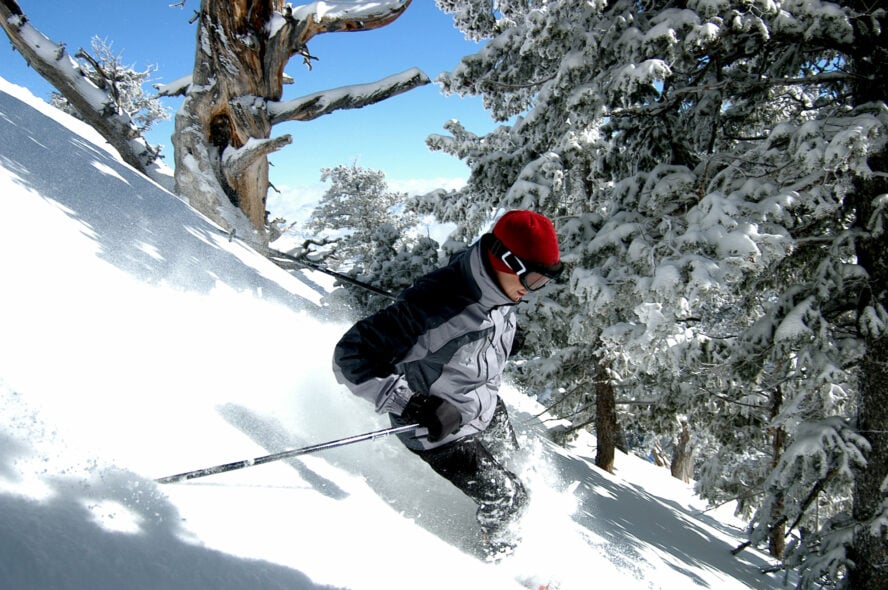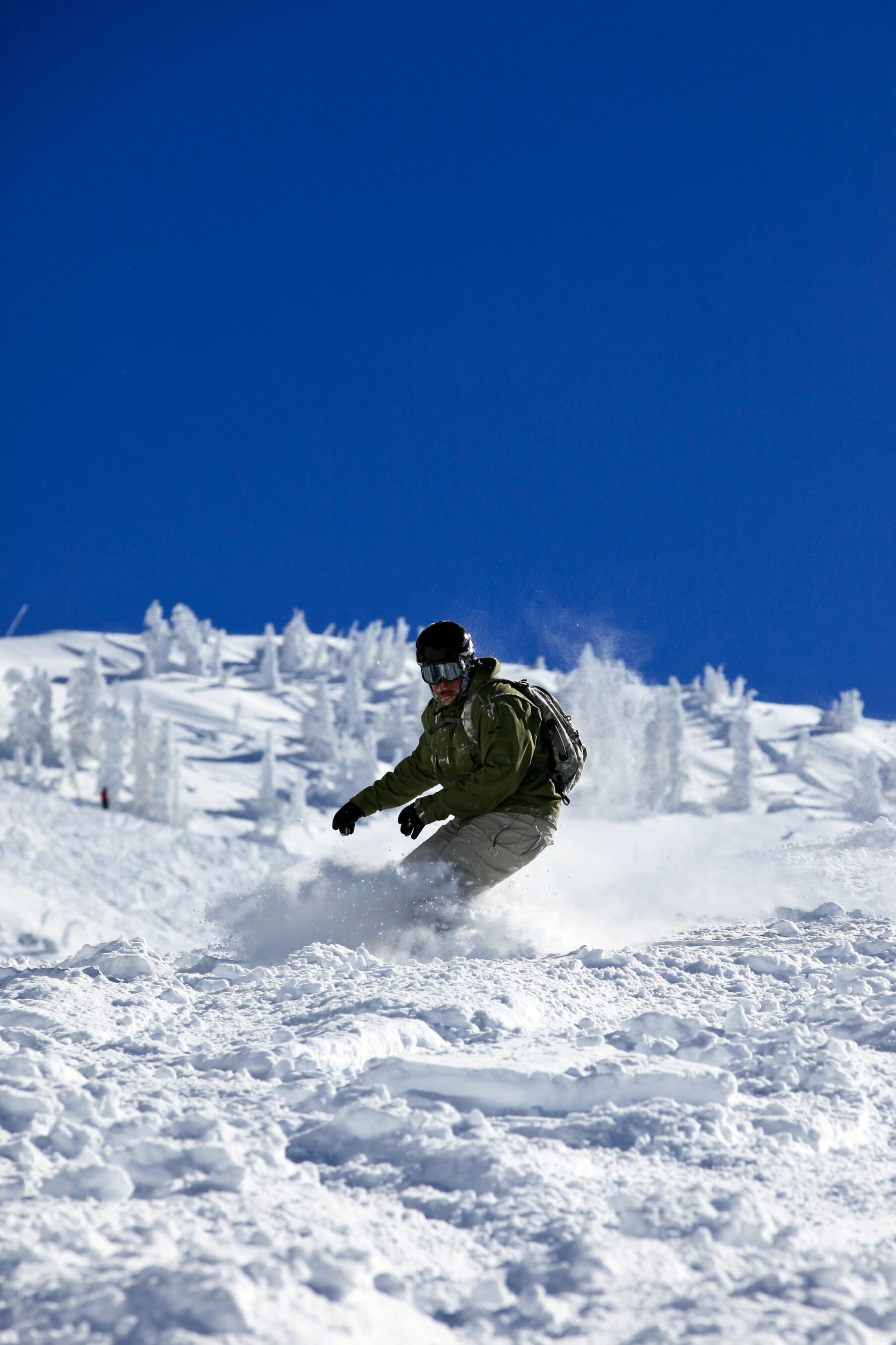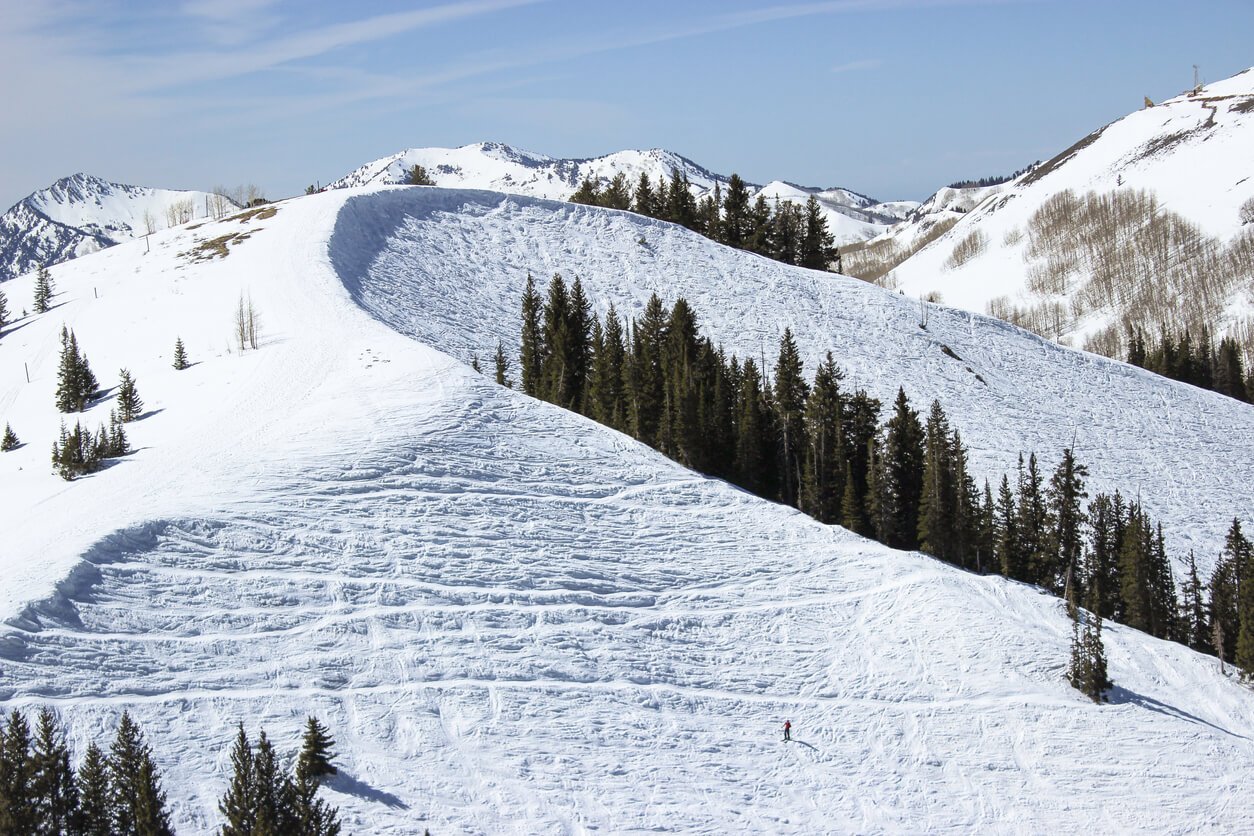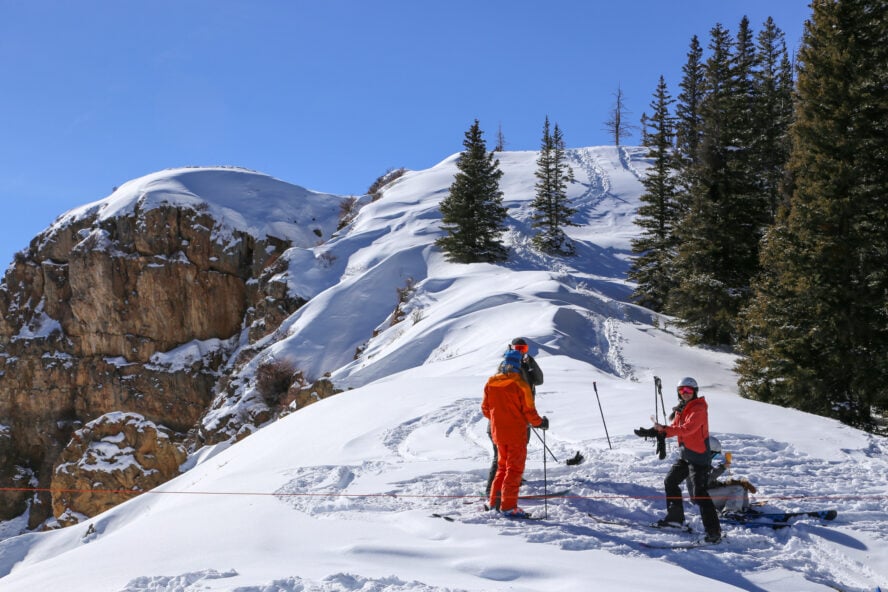Utah’s licence plates say “The Greatest Snow On Earth,” and anyone who’s gotten in a few backcountry runs can attest to this. By the time any of the 40 annual Pacific snowstorms make their way to Utah, they become proverbial ‘perfect storms’ and dump 500” of amazing, blower powder annually around Salt Lake City and the rest of Utah. All that snow, and tons of backcountry locations only 35 minutes from a major American airport make it easy to have the time of your life skiing the best powder in the world.

Wasatch backcountry skiing
There’s no doubt that the Wasatch Mountains hold the goods in Utah — Little Cottonwood Canyon around Alta and Snowbird, Big Cottonwood Canyon near Brighton and Solitude, the Back Wasatch — all areas that are renowned for their conditions and proximity to one another. Not even backcountry skiing in California lets you ski six resorts in one day. Beyond Wasatch, the La Sal Mountains have some solid places to ski right around Moab. There are tons of objectives for every level of skier, from mellow treeline runs like you’d find skiing in Tuckerman Ravine to steep couloirs and low angle meadows. So whether you’re a newcomer looking to earn you turns in the backcountry, crave some expert-level steep skiing, or want to tackle a multi-day adventure with friends, Utah has it all.
When is the best time to backcountry ski in Utah?
The backcountry skiing adventures in Utah usually kick off mid-November and last through April. The region typically gets 500” of snow, and in a good year, conditions can be favorable through late spring. The best month to ski in Utah is February. It typically sees the most amount of snow, with conditions generally staying prime until mid-March.
One last word to the tech-savvy: if you’re sticking around Wasatch, and let’s face it, most of us are, there’s an amazing app called Wasatch Backcountry Skiing Map available on both iOS and Android, it’s not free, but it has ALL the route beta you need to know.
1. Mount Superior
If there were a poster child for skiing in Utah, Mount Superior would be it. For those who’ve skied at Alta or Snowbird, it’s impossible not to draw an eye on Superior with its steep, white encased mass towering 3000’ above the Little Cottonwood Highway. The skiing is really good here. In fact, it’s skiable on all sides, which are comprised of steep, expert terrain where conditions need to be optimal before approaching anywhere near it.
Cardiac Bowl and the South Face
The two main faces for descents are Cardiac Bowl and the South Face. From the Alta trailhead, follow the Cardiff Pass route. Cardiac Bowl and Chutes can be gained after some demanding skinning along the ridgeline, which requires concentration and experience. From the bowl, you can ski to the south side and finish the ascent up the to the summit. If you’re looking for something a little crazier, you can mountaineer up the South Face, but do so with a guide. There’s little margin for error out there.
Mount Superior - Good to Know
Intermediate to advanced skiers
Couloirs, bowls and chutes
Mt. Superior 11,050’ (base); 3000’ vertical from the South Face
Drive your car. Park your car. Start your ascent. Skin and bootpack
Who would have thought the Great Salt Lake could make such great light powder?
The Chuting Gallery by Andrew McLean. Classic. Or, consider Backcountry Skiing Utah: A Guide to the State’s Best Ski Tours by Tyson Bradley
January-mid-March
Across the street from Snowbird
40.5921° N, 111.6670° W
2. Hogum Fork
When looking west from Snowbird it’s hard to miss the mass of peaks, ridges and chutes choking the skyline. Much of this terrain comprises the Lone Peak Wilderness Area, more specifically Hogum Fork. The terrain here is generally big, steep and above treeline with plenty of diverse options to choose, but you have to earn it.
Put in the work, reap the rewards
Compared to other areas, access here requires a good deal of effort and a big day but the reward of solitude and plethora of five-star terrain is unbeatable. This is a place best suited for experienced backcountry travelers in good shape. It’s also a location where the right snow and avalanche conditions are essential for safe travel.
Hogum Fork - Good to Know
Advanced and expert
Couloirs. Lot’s of Couloirs
1100’ at 50° for The Hypodermic Needle (approx. 5000’ all told) and Sliver Couloir
Long and demanding
Dry, perfect powder
The Chuting Gallery by Andrew McLean. Classic. Or, consider Backcountry Skiing Utah: A Guide to the State’s Best Ski Tours by Tyson Bradley
January-mid-March
Little Cottonwood Canyon, Utah
40°32’49″N 111°43’8″W
3. Alta and Snowbird
Believe the hype! If you’re looking for an abundance of dry powder, spaciousness that rivals the backcountry skiing in Canada AND excellent access, you don’t need to head to Colorado for such stellar backcountry skiing—the Alta and Snowbird ski areas are our little slice of heaven right here in Utah. Next-door neighbors, they both have their own unique vibes . But don’t be lulled into a false sense of security due to all the other skiers in the backcountry, more people means greater attention must be paid to snowpack and weather conditions. When in doubt, hire a guide to show you the best the area has to offer.
Alta backcountry skiing
One good thing to know about Alta: the resort doesn’t mind backcountry skiers using its snowcat route for backcountry access. A little inbounds to get out of bounds isn’t a problem. If you’re looking for slackcountry access, the Supreme lift will deliver you to the goods. On snow days, when the resort skiers are doing their thing it’s the perfect time to check out backcountry options.
An excellent starting point is Grizzly Gulch, which only requires a short skin and delivers quickly on skiable pow – great backcountry skiing for beginners. Catherine’s Pass (via Grizzly Gulch) is reachable by skinning or lift and offers fantastic bowl skiing with further access to the trio of Sunset Peak, Mount Tuscarora, and Pioneer Peak – all of which offer chutes, couloirs, bowls and trees of their own. Another option for the area is Flagstaff Mountain and Upper Days Fork, which can be tracked out fairly quickly, but is still worth getting up early to hit skiable chutes, bowls and trees. All of these options and more are attainable with skins. No resort pass required. Not bad.

Snowbird backcountry skiing
Snowbird routinely ranks as a top resort and its surrounding area ranks as a backcountry skiing paradise because there’s ample, varied and steep terrain everywhere you look. While there’s plenty for families to do here while on vacation, the advanced and expert skiers here will have plenty of hard slopes to carve and shred, some of which are as gravity-defying as the backcountry skiing in Washington. It’s not on everybody’s bucket list only because of its name.
Slackcountry access to White Pine Fork happens via a Snowbird backcountry gate, from where you can take a short hike to the west to Temptation Ridge and shred the Temptation Chutes, or traverse up the ridgeline and head for Birthday Chutes and Tri Chutes. In upper White Pine, there’s the spectacular Glacier Bowl and the West Pass. This area is also accessible via the White Pine Trailhead if you’re not based out of the resort. And if you feel like springing for it, there’s heli-skiing if you want that hard-to-reach pow.
Can you ski between Alta and Snowbird?
Yes, you can ski between Alta and Snowbird. The side-by-side resorts offer connected terrain, (with a new combined pass). The two mountains share a two-mile-long ridgeline that stretches from the top of Sugarloaf Pass, through to Baldy Shoulder, and then down to the bypass road. The double-resort pass offers skiers of every level a chance to experience all of the inbounds terrain that the whole area has to offer.
If you want to take full advantage of the area and head off-resort, Snowbird and Alta backcountry guides that offer day, weekend and week-long packages for all objectives. From beginner backcountry touring clinics for the whole family to expert-only choose your own adventure trips, there’s no shortage of fun to be had here. If you’re looking for an Alta and Snowbird backcountry trail map, you won’t find a better one than the Wasatch backcountry ski map mentioned above.
Alta and Snowbird - Good to Know
Advanced and expert skiers
Cirques, chutes, bowls, and plenty of powder and steep runs, and yes, cliff drops
10,026’ at Alta; Snowbird’s slightly higher at 11,000’
Ample slackcountry and backcountry access; use Alta lifts or use the Alta parking lot and skin up!
There are a whopping 551 inches of quality powder per season!
The Powder Hound’s Guide to Skiing Alta by Brad Asmus
January through April
Little Cottonwood Canyon, Utah, approximately 30 miles from Salt Lake City
Alta: 40°34′51″N 111°38′14″W; Snowbird: 40.5819° N, 111.6552° W
4. Mill D North Fork
There are few touring areas that provide as varied terrain as Mill D. Long known for its easy access aspen glade skiing, Mill D has a bit of everything, including plenty of advanced options. The drainage there also acts as a relatively safe harbor when avalanche hazard is elevated. It should be noted that there are plenty of approaches to diverse terrain regardless of hazard conditions. Mill D is a great stomping ground for new users but it also draws experienced folks due to its diversity and the forgiving nature of its terrain.
Mill D North Fork - Good to Know
Beginner to Intermediate
Glades, trees. Glades and trees.
1500’ vertical for Short Swing or 2100’ for Reynolds Peak
Easy and rewarding. Start skinning from Spruces Trailhead
Expect the same stellar conditions as the rest of Utah
The Chuting Gallery by Andrew McLean. Classic. Or, consider Backcountry Skiing Utah: A Guide to the State’s Best Ski Tours by Tyson Bradley
Alta-ish
40.64769°N 111.64289°W
January-mid-March
5. Solitude
The name says it all. Long considered a local’s locale, Solitude is far less crowded than its neighbors and offers plenty of Utah’s famous powder. Simply put, it’s a gem of a ski vacation destination where there’s plenty of skiable lines available after it’s more famous neighbors get tracked out. There’s a lot of family options and the resort itself has done much to bolster its standing amongst its other more frequented neighbors.
The best Solitude Mountain runs
The resort offers sidecountry access to challenging terrain in Honeycomb Canyon, where skiers can discover chutes and wide-open powderfields in Wolverine Cirque. For even more of an adrenaline rush, there’s Fantasy Ridge which requires a hike over very exposed terrain that leads to narrow shoots and other technical delights — all of which is just a short trek from the resort. You can also skip the resort, too, and find access to Silver Fork Canyon and Honeycomb by parking at the lower Solitude lot and skinning/bootpacking up to Silver Fork for runs like Silver Spoon, Meadow Chutes and Brad’s Line. Also attainable from the Solitude lot is USA Bowl, which has good tree skiing, with other options further beyond, like South Monitor and Scott Hill.
Solitude - Good to Know
Beginner to advanced
Amazing tree skiing
10,035’
There’s solid slackcountry access at the resort, and in the resort’s parking lot. Be sure not to park there if not staying at the resort, look for legal parking on the road instead
All the powder that Utah is known for
All the goodies are available here
Mid-January through April
Big Cottonwood Canyon, Salt Lake County
40°36′54.5″N 111°35′20.1″W
6. Brighton
As the first ski resort in Utah, Brighton has something for everybody: there’s family-friendly trails, lots of night skiing and amazing slackcountry and backcountry terrain. It’s also a world-famous destination for snowboarders, too, so if you’ve got one in your group (or your family), there’ll be something for everyone. What makes Brighton so special is it is a perfect place for regular resort skiers to get a taste of the backcountry.
Hidden Canyon, Mt. Millicent and the Wolverine Cirque
Just off of the Great Western Lift is Hidden Canyon which offers some of the easiest backcountry access you’ll find, and runs lasting for days after a storm. On the other side, the lines off of Mt. Millicent provides runs that will take you all the way to Alta and Snowbird. And just beyond Millicent is the Wolverine Cirque, with insanely steep chutes.
Brighton - Good to Know
Beginner to expert skiers
Drop-offs, chutes, bowls and lots of mellow tree skiing
10,750’
There’s easy slackcountry access to some of the best backcountry in the US, complete with affordable single-ride lift tickets
Brighton has some of the coldest and driest snow in the world, and there’s plenty of it throughout the season.
Backcountry access can be found on this Brighton backcountry map here (look for the yellow triangles)
January through mid-April
Salt Lake County
40°36′0″N 111°35′0″W
7. Park City
Park City might be famous for hosting some of the best mountain biking in Utah, but not many know that the Park City Mountain Resort is also the largest ski area in the United States. This means that there’s tons of paths and activities to choose from, whether you’re an adventure seeker, luxury traveler or going on a family vacation. If you’re looking to ski off-resort all together, there are plenty of Park City backcountry ski tours available, with guides who can introduce you to the best — and least crowded — places, with access as easy as the backcountry skiing in Jackson Hole.
The Park City Ridgeline
More important, though, are the backcountry runs available both within and without the resort, collectively known as the Park City Ridgeline. While you can get to the ridgeline directly from the resort, the terrain and its bowls and treelines are attainable from outside the resort, mostly on the Solitude and Brighton side of Big Cottonwood Canyon. Regardless, if you’re not too proud to take PCMR’s giant lift, the 9990, explore the southern half of the ridgeline and ski the classic Monitor Bowls or No Name bowl, all of which offer steep and sustained runs. They’re also huge. On the northside of the Ridgeline consider Dutchess Draw and McDonald’s Draw each with big, each skiable and mega on powder days.
Park City - Good to Know
Intermediate, advanced, expert
Bowls and gladed areas
10,026’
Easy access to backcountry skiing with the Ninety-Nine 90 Express within the park. The ridgeline is accessible if you want to skip the lines
Moderate amounts of dry Utah snow during the entire season
Ski area boundaries and routes are available here
Mid-January through early April
Park City, Utah
40°39′3″N 111°30′27″W
8. La Sal Mountains
The Wasatch Mountain Range might come to mind for most when they think of the best backcountry ski spots in Utah, but there’s another truly great location, definitely off the beaten path, that bears mentioning as a serious destination for any backcountry skier: La Sal Mountains, just outside of Moab! While the majority of people only know of the best mountain bike trails in Moab, locals who are more familiar with the area are taking advantage of its 12+ 12,000’ mountains for backcountry skiing objectives.
Backcountry runs for all skill levels in Moab
Whether you want to find powder stashes in the Corkscrew Glades or shred the vertical on Mount Tukuhnikivatz (Mount Tuk, as it’s affectionately known to locals), the access for most lines and runs is straightforward thanks to Moab being a solid spring and summer recreation destination. There’s paths everywhere and lots of trailhead options.
One of the easier runs is Haystack Mountain, which, with its south and east-facing aspects, serves up plenty of corn come spring. For the backcountry skier looking for something more challenging, be sure to check out Mount Mellenthin. The summit ascent requires a lot of care and preparation (cliffs! avalanches! beware!), but there are high angle chutes and bowls waiting for you on its north face.
So, while the 3.5hr drive from SLC may not be on the top of everyone’s weekend ski list, those who decide to make the journey will find themselves soon planning out their next trip back. Knock off work early on a Friday, and you’ll log two full weekend days of backcountry skiing before you need to make the drive home.
La Sal Mountains - Good to Know
Beginner to advanced
Depending on which objective you take, the terrain is diverse: trees, glades, high angle, chutes and couloirs
12,721’ Mount Peale
The access here is good and relatively straightforward, depending on your objective. This is a mountain biking and hiking hotspot in the warmer months, so there’s ample snow covered trails to get where you need
Good and light powder
Backcountry Ski & Snowboard Routes: Utah by Jared Hargrave
March-April
Moab, Utah
38.4489° N, 109.2412° W
Grab a cup at Moab Coffee Roasters, where they roast their own beans
Get a pint and a burger at the family-friendly Moab Brewery































